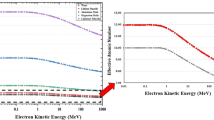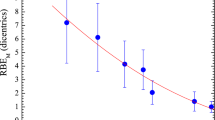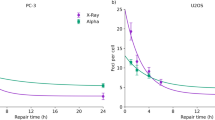Abstract
THE extent to which oxygen enhances radiation damage in biological systems is known to depend on the type of radiation used1–4. Quantitatively, this effect may be represented by the oxygen enhancement ratio (OER), which is defined as the ratio between the doses of radiation required to produce equal degrees of damage in anoxic and oxygenated cells5. High values of the OER, that is, between 2.5 and 3.5, are usually observed for radiations of low mean linear energy transfer (LET), for example, X- or γ-rays, while with radiations of high mean LET, lower OER values are measured. In a series of experiments reported recently, the variation of the OER with LET has been investigated for deuterons and α-particles of different energies, using the capacity for clone formation as a test of the survival of cultured cells of human origin6. An experimental design which allowed selected segments of the tracks of these particles to pass through the cells enabled energy dissipation patterns with narrow LET distributions to be obtained. It was shown that the OER values decrease with increasing LET from 2.6 at 5.6 keV/µ of unit density tissue to a value of 2.05 at 61 keV/µ, followed by a more rapid decrease to 1.0 at 165 keV/µ.
This is a preview of subscription content, access via your institution
Access options
Subscribe to this journal
Receive 51 print issues and online access
$199.00 per year
only $3.90 per issue
Buy this article
- Purchase on Springer Link
- Instant access to full article PDF
Prices may be subject to local taxes which are calculated during checkout
Similar content being viewed by others
References
Conger, A. D., Brit. J. Radiol., 26, 642 (1953).
Hornsey, S., and Silini, G., Int. J. Radiat. Biol., 4, 135 (1961).
Berry, R. J., and Andrews, J. R., Ann. N.Y. Acad. Sci., 114, 48 (1964).
Barendsen, G. W., Ann. N.Y. Acad. Sci., 114, 96 (1964).
Alper, T., and Howard-Flanders, P., Nature, 178, 978 (1956).
Barendsen, G. W., Koot, C. J., Kersen, G. R., van Bewley, D. K., Field, S. B., and Parnell, C. J., Int. J. Radiat. Biol., 10, 317 (1966).
Fowler, J. F., in Biological Effects of Neutron and Proton Irradiations, IAEA conf., Brookhaven, 1963, 185 (1964).
Berry, R. J., Oliver, R., and Porter, E. H., Nature, 199, 923 (1963).
Rossi, H. H., in Biophysical Aspects of Radiation Quality, IAEA conf., Vienna, 1965, to be published (1966).
Broerse, J. J., and Barendsen, G. W., Nature, 206, 208 (1965).
Schneider, D. O., and Whitmore, G. F., Radiat. Res., 18, 286 (1963).
Author information
Authors and Affiliations
Rights and permissions
About this article
Cite this article
BARENDSEN, G., BROERSE, J. Dependence of the Oxygen Effect on the Energy of Fast Neutrons. Nature 212, 722–724 (1966). https://doi.org/10.1038/212722b0
Issue Date:
DOI: https://doi.org/10.1038/212722b0
This article is cited by
Comments
By submitting a comment you agree to abide by our Terms and Community Guidelines. If you find something abusive or that does not comply with our terms or guidelines please flag it as inappropriate.



